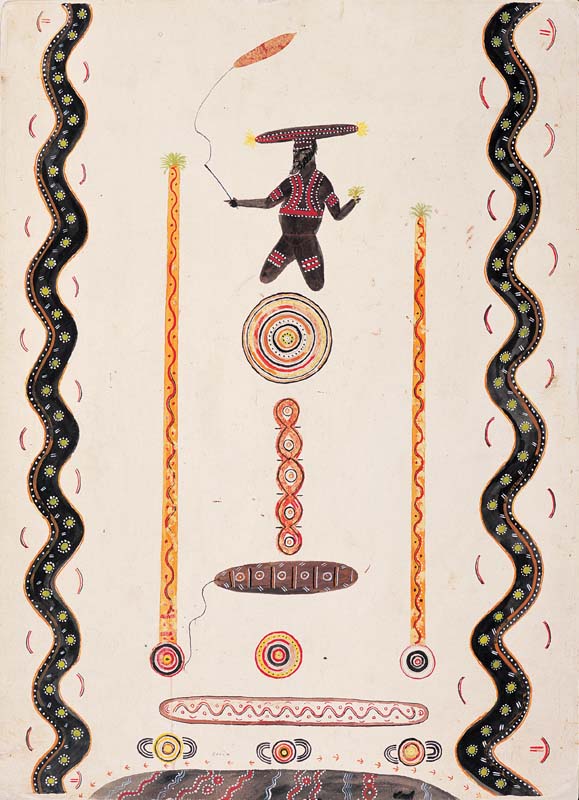We acknowledge the Traditional Owners of the land on which the Queensland Art Gallery | Gallery of Modern Art stands and recognise the creative contribution First Australians make to the art and culture of this country.

Kaapa Mbitjana Tjampitjinpa / Anmatyerre/Arrernte people / Australia c.1925–89 / Untitled c.1950–60 / Watercolour on wove paper on cardboard / 37.5 x 54.5cm / Gift of Anthony and Beverly Knight through the Queensland Art Gallery Foundation 2004 / Collection: Queensland Art Gallery | Gallery of Modern Art / © Estate of the artist/Licensed by Aboriginal Artists Agency Ltd
Kaapa Mbitjana TjampitjinpaUntitled 1971
Not Currently on Display
This early work by Kaapa Mbitjana Tjampitjinpa depicts traditional motifs that reference ceremony and country. His distinctive personal style shows the symmetrical format and overt iconography that preceded the use of over painted dotting techniques for which the Papunya movement became renowned.
This work is a visual description of a ceremony. Here Tjampitjinpa has depicted a figure holding a sacred bullroarer summoning men for ceremony and warning the women to stay away. Windbreaks frame this work, surrounding visual aspects of ceremonial performance that profile ceremonial poles and other sacred objects. A figure is shown at the top centre of the image wearing ceremonial body paint and a corroboree hat.
Kaapa Mbitjana Tjampitjinpa was born around 1925 on Napperby Station, north-west of Alice Springs (Mpwarntwe) in the Northern Territory. He worked as a stockman at Mount Riddock Station, south of Urapuntja (formally known as Utopia), before moving to Papunya in the late 1950s/early 1960s. He was a member of the Anmatyerre/Arrernte people and an elder of the Haasts Bluff (Ulumpawarru) region.
Tjampitjinpa regularly painted the Owl, Shield, Witchetty Grub, Pelican, Snake, Black Goanna, Emu and Yam Dreamings. He was one of the original artists involved with the painting movement at Papunya and was chosen by the other men as the principal adviser to paint the Honey Ant Dreaming mural on the Papunya school wall – one of the acts that propelled Contemporary Indigenous Australian art into the mainstream.
In 1971 he shared the first prize for his painting Gulgardi in the Alice Springs Caltex Golden Jubilee Art Award. This award was important in that it broke through the barriers that excluded Aboriginal art from being accepted as ‘art’ as opposed to ‘folk art’. The judges’ decision created an uproar among the non-Indigenous painters of Alice Springs; however, Tjampitjinpa’s triumph was lauded in the wider Australian art community. In 1972 Tjampitjinpa became the first Chairman of Papunya Tula Artists – the first company entirely owned and directed by Aboriginal people from the Western Desert.
Tjampitjinpa’s early paintings were also controversial in that they revealed aspects of ceremonial performance usually forbidden to outsiders. In the early days of the Papunya Art movement there were fierce debates within the Warlpiri and Anmatyerre groups over censorship which led to the development of ‘over dotting’ techniques to hide sacred imagery. This led to the ‘dot and circle’ school of painting.